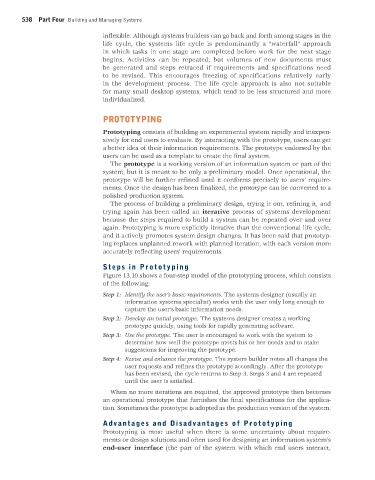Page 539 -
P. 539
538 Part Four Building and Managing Systems
inflexible. Although systems builders can go back and forth among stages in the
life cycle, the systems life cycle is predominantly a “waterfall” approach
in which tasks in one stage are completed before work for the next stage
begins. Activities can be repeated, but volumes of new documents must
be generated and steps retraced if requirements and specifications need
to be revised. This encourages freezing of specifications relatively early
in the development process. The life cycle approach is also not suitable
for many small desktop systems, which tend to be less structured and more
individualized.
PROTOTYPING
Prototyping consists of building an experimental system rapidly and inexpen-
sively for end users to evaluate. By interacting with the prototype, users can get
a better idea of their information requirements. The prototype endorsed by the
users can be used as a template to create the final system.
The prototype is a working version of an information system or part of the
system, but it is meant to be only a preliminary model. Once operational, the
prototype will be further refined until it conforms precisely to users’ require-
ments. Once the design has been finalized, the prototype can be converted to a
polished production system.
The process of building a preliminary design, trying it out, refining it, and
trying again has been called an iterative process of systems development
because the steps required to build a system can be repeated over and over
again. Prototyping is more explicitly iterative than the conventional life cycle,
and it actively promotes system design changes. It has been said that prototyp-
ing replaces unplanned rework with planned iteration, with each version more
accurately reflecting users’ requirements.
Steps in Prototyping
Figure 13.10 shows a four-step model of the prototyping process, which consists
of the following:
Step 1: Identify the user’s basic requirements. The systems designer (usually an
information systems specialist) works with the user only long enough to
capture the user’s basic information needs.
Step 2: Develop an initial prototype. The systems designer creates a working
prototype quickly, using tools for rapidly generating software.
Step 3: Use the prototype. The user is encouraged to work with the system to
determine how well the prototype meets his or her needs and to make
suggestions for improving the prototype.
Step 4: Revise and enhance the prototype. The system builder notes all changes the
user requests and refines the prototype accordingly. After the prototype
has been revised, the cycle returns to Step 3. Steps 3 and 4 are repeated
until the user is satisfied.
When no more iterations are required, the approved prototype then becomes
an operational prototype that furnishes the final specifications for the applica-
tion. Sometimes the prototype is adopted as the production version of the system.
Advantages and Disadvantages of Prototyping
Prototyping is most useful when there is some uncertainty about require-
ments or design solutions and often used for designing an information system’s
end-user interface (the part of the system with which end users interact,
MIS_13_Ch_13 global.indd 538 1/17/2013 2:31:24 PM

